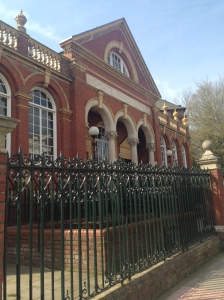 By Green Councillor, Sian Berry
By Green Councillor, Sian Berry
At today’s council meeting, I’m putting a motion that will ensure the council keeps monitoring air pollution, despite Government attempts to reduce what’s collected. Along with Councillor Flick Rea, I’m also warning about the dangers HS2’s long construction period will pose to the health of local people – a report on this in the CNJ.
Air pollution is a huge problem. In London at least 4,000 early deaths a year are caused by it, and the latest estimates (which include the main traffic pollutant nitrogen dioxide not just the dangerous particles) show many more are in fact being harmed, with children especially vulnerable.
The European Court of Justice has recently ruled that public authorities in the UK must take action to achieve levels of pollution within nitrogen dioxide limits “as soon as possible”, and last month the Environmental Audit Committee in Parliament warned against reducing requirements to monitor air pollution, saying that: “The Government should ensure… that its desire to reduce red tape will not be allowed to undermine robust air quality monitoring across the country.”
Our motion concerns a proposal from the Govt Department for Environment, Food and Rural Affairs (whose public consultation on this was very cheekily launched just before Christmas), to stop requiring local councils to measure air pollution. This would be a disaster in Camden. Many local areas rely on the council’s monitoring programme for information on the air pollution they are living with. The national network of monitoring stations, run by Defra, only includes three sites in the most polluted areas, but Camden’s additional data shows that all but one area (Frognal) is over legal limits.
Local schools and campaign groups, including Camden Green Party, have also carried out air pollution measurement in some local areas, for example:
In Highgate, we found all our residential streets were over the legal limits in December 2013
In the areas set to be affected by HS2 construction works and vehicles, campaigners measured existing pollution last year, finding extremely high levels
Several schools are also carrying out ‘citizen science’ experiments to measure the air pollution they face.
These ad-hoc studies run by the community are very useful in raising awareness of the problem and providing snapshots of data, but are no substitute at all for the regular monitoring carried out by Council officers in providing a consistent, detailed long-term picture of the state of our air.
The motion being proposed at tonight’s meeting is below. Labour councillors have put forward an amendment that would water it down by asking HS2 Limited to pay for the new monitoring stations around Euston, with no commitment for Camden to pay if they refuse. I don’t agree with this and hope the original motion will get through. If you want to see what happens, the council meeting will be webcast as usual and you can watch it here: http://democracy.camden.gov.uk/ieListDocuments.aspx?CId=149&MId=5344
Motion proposed by Cllr Flick Rea and seconded by Cllr Sian Berry
This council notes with concern that air pollution leads to at least 4,000 early deaths a year in London, and possibly many more. It causes heart attacks, strokes, cancer and worsens a wide range of respiratory diseases. Growing up breathing polluted air means that children living near busy roads have under-developed lungs, with health consequences throughout their lives.
We are therefore concerned at proposals from the Department for Environment, Food and Rural Affairs (Defra), in a consultation launched just before Christmas, to remove requirements for local authorities to model and monitor local air pollution in detail – a proposal which itself admits that local pollution hotspots are likely to be left out of replacement national monitoring.
Defra currently supports only 273 air pollution sites nationally – including Russell Square, Bloomsbury and partial funding of Camden’s Swiss Cottage monitoring site. Camden Council measures both particulate and gaseous pollution automatically at two further sites (Euston Road and Shaftesbury Avenue).
Camden also regularly measures, using diffusion tubes only, average Nitrogen Dioxide (NO2) levels at a further 12 locations across the borough. In 2013 NO2 levels exceeded the EU annual mean legal limit concentration of 40 micrograms per cubic metre in every single location, except Frognal. The three sites with greatest consistent exceedences have (since 2011) been Euston Road, Tottenham Court Road and Finchley Road.
We believe that the more we know about the air we breathe, the more we will do to improve it, and therefore call on the Leader of the Council and the Cabinet to respond to Defra’s consultation by the deadline urging the retention of consistent requirements for local authorities to monitor air pollution and to pledge that local air pollution monitoring throughout our borough will be maintained at least at its current level.
Particulate pollution is a particular health risk, and comes from diesel vehicles and a range of other sources, including construction, which is why we are particularly concerned about the cumulative effect on residents living near HS2’s prospective massive construction site around Euston.
Therefore we also urge Camden to additionally set up automatic monitoring of gas and particulates in both Eversholt Street and Hampstead Road. This must be done soon so that residents with health concerns have at least a year of baseline evidence prior to construction, rather than their current unsatisfactory need to rely on modelling from monitoring stations well out of area.



